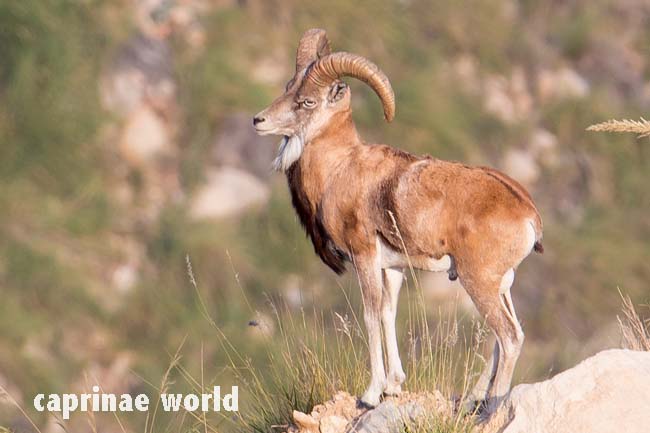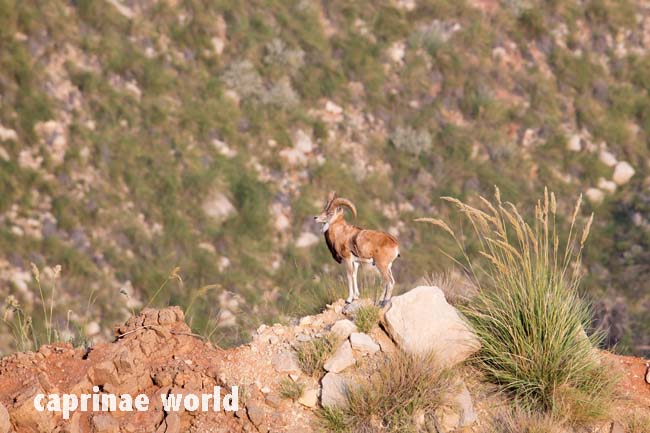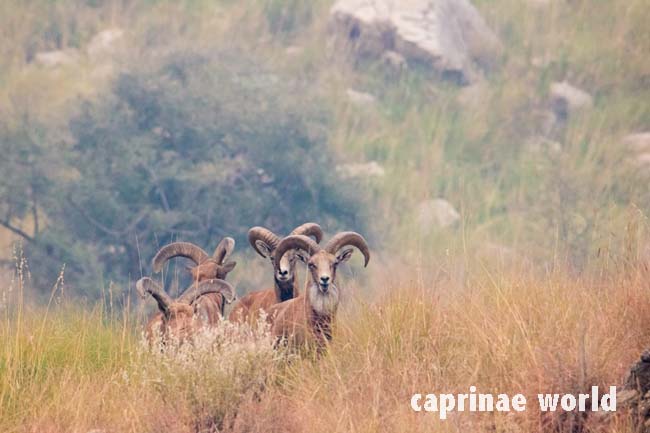Punjab Urial are endemic to Pakistan and were once present over all northern Punjab Province, but have disappeared from much of their historic range. [2]
Name
Baluchi and Sindi: Koch, gad (male), garand (female) [2]
English common name: Punjab Urial [2, 16], Salt Range Urial [2]
German: Punjab-Wildschaf [16], Punjab Kreishornschaf [2] ((editor’s note: the term „Kreishorn“ – meaning „circle horn“ – should be abandoned; it doesn’t help at all to describe a wild sheep; since all sheep basically have „circled horns“))
French: Mouflon de Punjab [16], Urial de Penjab [2] ((editor’s note: a misspelling?)
Pashto: Koh-i-dumba [2]
Punjabi: Hureal, oorial [1]
Spanish: Urial del Punyab [16], Urial del Punjab [2]
Tamil: Airppiyak kàttuàtu [2]
Urdu: Jangli Dumba, Gud [2]
Other (putative) scientific names and synonyms
Ovis orientalis punjabiensis, Lydekker 1913 [2]
The name orientalis is based on a hybrid population in north-central Iran and is not usable. [16]
Taxonomy
Ovis vignei punjabiensis, Lydekker 1913, Pakistan [2, 16]
Similar subspecies
The Punjab Urial has a redder colour than the Ladakh Urial [4]; it might be even redder than other Urial subspecies in general [1]. The Punjab Urial appears smaller and stockier than the Afghan Urial (O. v. cycloceros) [1, 2]. Groves and Grubb (2011) found that the Punjab Urial is quite distinct from the Ladakh Urial, and evidently has much in common with the Bukhara Urial (perhaps symplesiomorphic: a greater skull height and long nasals, contrasting with a lower skull length and breadth). [4]
Karyotype: 2n=58 [2]
Distribution
Pakistan / Punjab province [16] and Khyber-Pakhtunkhwa province [2]
Punjab Urial are endemic to Pakistan and were once present over all northern Punjab Province, but have disappeared from much of their historic range. [2]
Table 1: Punjab Urial locations [2]
| location | topography |
| Salt Ranges, Kala Chitta Ranges | to the north of Jhelum River and to the east of Indus River |
| Margalla Mountain Range (forest belt) | small-elevation hills, north of Islamabad |
| Rakh Topi Game Reserve and Boraka Wildlife Sanctuary | Kohat district, western side of the Indus |
| Kalabagh Game Reserve (main Punjab Urial population) | 25 km southeast of Kalabagh, Jaba Masan Valley, westerly extension of Salt Ranges |
| Chumbi Surla wildlife sanctuary | 30 km nnw of Khushāb |
| and Rakh Jalalpur wildlife sanctuary | – |
| Lehri Nature Park ((or Keri?)) | Keri is 20 km north of Khushāb |
General discription
The Punjab Urial appears smaller and stockier than the Afghan Urial (O. v. cycloceros). [2]
head-body: 109-116 cm (males) [16]
shoulder height: 78-92 cm (males) [16]; 81 cm (male) [2]
weight males: 40-45 kg (males) [16]; about 40 kg [2];
weight females: ca. 25 kg [2, 16]
tail: 10,9-11,9 cm [16]
Coloration / pelage
General body colour is dark rusty red [2]
winter coat: more reddish than in other Urials [2]
underparts: whitish; a dark band separates the upper parts from the underparts (2)
rump: whitish [2]
limbs: lower legs are whitish with black knee patches and black ankles. [2]
bib (only in males): white [16]
neck ruff (only males): black [16]; extending to the brisket [2]; lost during the spring molt [16]
but bib / ruff colour also varies: in some, the beard is snow white and the ruff jet black; in others, both are gray, with the ruff always somewhat darker than the beard (Stockley 1922) [2]
saddle patch (only males): sometimes shown in mature males, with mixed black and white hairs, but it may be absent or only white (Schaller 1977) [2]; usually white, but the patch can be bicolored or absent [16]
Horns
The sickle-shaped heteronymous horns of rams curve somewhat tightly backward and downward. Ewes possess straight slender horns rarely exceeding ear length. [2]
mean horn length (N=66): 70,8 cm [2]
mean basal circumference: 23,8 cm [2]
tip-to-tip-spread range: 11,4 to 42,5 cm [2]
record length for Punjab Urial in Rowland Ward: 98,4 cm (from Attock, 1927) [2]
basal circumference (same animal): up to 24,8 cm [2]
tip-to-tip-spread (same animal): up 24,1 cm [2]
Habitat
Prevailing habitat of the Punjab Urial consists of stony, rounded hills in dry, subtropical semi-evergreen scrub forest at 250 to 1.000 metres above sea level. The hills are interspersed with gullies and ravines. In the Kalabagh Game Reserve in the Salt Range, yearly rainfall is 452 millimetres and 60 per cent of precipitation occurs during summer. Although Punjab Urials usually avoid tall vegetation, they do enter tall vegetation habitats for thermal and security cover and for foraging. However, they are more often found in rugged topography with low vegetation cover. Areas with tall dense vegetation are the least utilized. They share habitats with domestic sheep, goats, and cattle. [16]
Food and feeding
Punjab Urials – like all other Urials – are primarily grazers, feeding on grasses and sedges, but they can switch to browse during the autumn and winter when grasses have lost their nutritional value.
In a study within a protected area devoid of livestock they fed on 44 plant species, and their annual diet consisted of 67 per cent grasses, 18 per cent forbs, and 16 per cent browse (shrubs and trees). Diet overlap with domestic sheep and goats may be significant. [16]
Predators
Predators include feral dogs (Canis lupus familiaris), Red Foxes (Vulpes vulpes), and Golden Jackals (Canis aureus). The latter two predators could prey on lambs. Grey Wolves (Canis lupus), Caracals (Caracal caracal), and Leopards (Panthera pardus), formerly the major predators, were extirpated. [16]
Breeding
sexual maturity – males: by age two, but probably are not sexually active until their fourth year. [16]
sexual maturity – female: at 1,5 years; give birth at age two [16]
mating season: October-November [2, 16]
mating behaviour: Urials are serially polygynous. Larger, dominant rams actively seek ewes in estrus. A male mates with one estrous ewe at a time; it does not form harems. [16]
gestation period: 150-160 days [16]
period of parturition: early April [2, 16]
behaviour at birth: separate from the herd one or two days before giving birth; within a week after birth, lambs are able to follow their mothers even in rough terrain. [16]
number of young: 1 (in one study of a population in a protected area, 15 % of pregnant ewes had twins) [16]
lamb survival: averaged 55 % [16]
yearling survival: 88 % [16]
2-3 year-old survival: 47 %, (a low percentage for ungulates, but was possibly influenced by emigration; survival was adequate to allow for population growth. [16]
Activity pattern
Punjab Urials are principally diurnal [16] and gregarious [2]. At temperatures of 27-29°C, they avoid open areas. [16]
In one study animals began feeding at sunlight, between 4:30 h and 6:00 h during warm weather, but they retreated into shade by 7:30 h and did not feed again until 17:00 h and later. During the warm season, they probably forage at night. During cooler weather, they fed until 9:00-10:00 h, then retreated to shaded plant cover until 16:00 to 16:30 h. During winter, they can remain in the open throughout the day, grazing and resting intermittently. [16]
Movements, Home range and social organisation
Within a 40-km² protected area, Punjab Urials formed two to five aggregations of variable herd numbers, with few solitary individuals. They occasionally form herds of 30 to 40 individuals, but most female herds consisted of 4 to 6 members. [16] Others have found group sizes to be between 5 and 7. [2] Most males segregate into ram herds during the birthing period, but yearling rams usually remain with ewe groups. Ram herds usually consist of rams of equal age or social status. [16] In winter when forage quality is low, larger groups are formed than in other seasons and more open habitat is used. Awan (2006) observed a female-biased sex ratio for the entire Salt Range. [2]
Punjab Urials avoid domestic animals. In interactions observed between Punjab Urials and domestic sheep and goats, Urials moved away in 78 per cent of encounters, and there was a flight reaction in the livestock in only 7 per cent of the interactions. [16]
Population
The Punjab Urial population has probably undergone a 50 per cent decline in the last 25 years [16]. ((editor’s note: figure published 2011)) However recent figures seem to indicate a change of trend (see table 2).
Table 2: Various population estimates for the Punjab Urial [2]
| location | population estimate | source |
| Kalabagh Game Reserve (KGR) – ca. 25 km se of Kalabagh, Salt Range, 3.899 km2 | 2.157 | Mirza et al. (1980) |
| KGR | 800-850 | Hess et al. (1997), Garstang (1999) |
| outside KGR | 200-250 in four other sub-populations | Hess et al. (1997), Garstang (1999) |
| Eastern section of Salt Range – ESR (Lehri, Jalapur, Kotal Kund) | 160 | Awan et al. (2004) |
| Jalapur WS | 130 | Mirza (2006) |
| Salt Range | 860 | Awan et al. (2004) |
| total throughout range | 1.550 | Chaudhry (1992) |
| total | less than 2000 in four to five populations | Tareen (1999) |
| total | 1.000-1.100 | Hess et al. (1997), Garstang (1999) |
| total |
2.500 – increase from 1.500 (2005) to 2.150 (2010) to 2.500 (2011) |
Punjab Wildlife & Parks Department Preservation (2011); Wildlife of Pakistan Website |
Threats
One of the greatest threats is the overutilisation of rangelands by domestic livestock, principally domestic sheep, goats, and cattle, which number in the thousands each in the Salt Range. Domestic ungulate ectoparasites and diseases can readily be transferred to Urials. [16]
Lungworms (Cystocaulus) are common parasites, as are roundworms such as Trichuris and Trichocephalus, The Punjab Urials can also be infected with coccidia (Eimeria).
The diet overlap between Urials and domestic sheep can be signifiant and can result in competition.
Overexploited rangelands can also negatively affect ram horn growth. In the Punjab, 74 per cent of the 23 plant genera consumed by Punjab Urial and domestic sheep were eaten by both. Domestic sheep are potential forage competitors. Diets of domestic sheep are also dominated by grasses, consisting of 72 per cent grasses, 13 per cent forbs, and 14 per cent browse on an annual basis. Although domestic goats are primarily browsers, they are also potential competitors, because Punjab Urials increase their intake of browse during the critical winter period. [16]
Other direct human threats include poaching, removal of wood for fuel and grass for fodder and lamb poaching. [16]
Ownership of a pet Urial is a status symbol in Pakistan (Awan 2001). In fact the pet trade appears to be the greatest short-term threat to the survival of Punjab Urial (Awan 2006). There appears to be a relatively high incident of lamb poaching in the eastern section of Salt Range (ESR). [2] In an unprotected area near human habitation and with lax anti-poaching enforcement, poachers removed about a quarter of the lamb crop for sale in the pet trade and shot all rams older than six years of age. In the Kalabagh Game Reserve, where wildlife laws are strictly enforced, fewer than 5 per cent of the lambs were removed and about 34 per cent of adult rams were six years of age or older. [16]
Conservation
The Punjab Wildlife Protection, Preservation and Management Act (1974) placed the Punjab Urial under protection. One National Park, five wildlife sanctuaries and two game reserves were created in its distribution range. [2] Today viable populations of Punjab Urial occur only in these protected areas [16] – see Table 1.
Trophy hunting
Punjab Urial have been protected through hunting in the Kalabagh Game Reserve (KGR, 137 km²) since the early 1930s. Here Urials are sheltered from poaching and its core range experiences no forage competition with livestock. Mature males were harvested within a restricted trophy hunting program until 1974, which produced six to ten Class IV rams near the end of their natural life span annually (Frisina 2001). The same author conducted a survey and counted 259 Urials and suggested that a hunting quota of five Class IV rams would be sustainable. Awan et al. (2004) reported that KGR would support about 500 animals. In the KGR the local community is fully involved in conservation and the Urial population in the reserve is viable in terms of population and genetic processes. What happend between 1974 and 2003 is not known, however a sustainable trophy harvest quota was established in 2004 (Awan 2006). [2]
The Punjab Wildlife & Parks Department annually puts a limited number of Punjab Urial trophy hunting permits on public auction. For the season from 1st December 2011 to 15th March 2012 the Department auctioned eight permits for hunts in community-managed Urial conservation areas of Chakwal and Jhelum districts. Each hunt must be completed within seven consecutive days. [2]
Ecotourism
not a factor
Literature cited
[1] Castelló, José R., 2016: Bovids of the World – Antelopes, Gazelles, Cattle, Goats, Sheep, and Relatives. Princeton University Press
[2] Damm, Gerhard R. and Franco, Nicolás, 2014: The CIC Caprinae Atlas of the World – CIC International Council for Game and Wildlife Conservation, Budakeszi, Hungary in cooperation with Rowland Ward Publications RSA (Pty) Ltd., Johannesburg, South Africa
[4] Groves, Colin and Grubb, Peter, 2011: Ungulate Taxonomy. The John Hopkins University Press
[16] Wilson, D. E. and Mittermeier, R. A. [eds], 2011: Handbook of the mammals of the world. Vol. 2. Hoofed mammals. Lynx Edicions, Barcelona.




